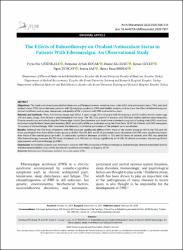| dc.contributor.author | Çetinkaya, Feyza Nur | |
| dc.contributor.author | Koçak, Fatmanur Aybala | |
| dc.contributor.author | Kurt, Emine Eda | |
| dc.contributor.author | ... | |
| dc.contributor.author | Erdem, Hatice Rana | |
| dc.contributor.author | Şaş, Senem | |
| dc.contributor.author | Tuncay, Figen | |
| dc.date.accessioned | 2025-03-19T07:01:44Z | |
| dc.date.available | 2025-03-19T07:01:44Z | |
| dc.date.issued | 2020 | en_US |
| dc.identifier.citation | Cetinkaya, F. N., Kocak, F. A., Kurt, E. E., Güçlü, K., Tuncay, F., Şaş, S., & Erdem, H. R. (2020). The effects of Balneotherapy on Oxidant/Antioxidant status in patients with Fibromyalgia: an observational study. Archives of Rheumatology, 35(4), 506. | en_US |
| dc.identifier.issn | 2148-5046 | |
| dc.identifier.issn | 1309-0283 | |
| dc.identifier.uri | https://10.46497/ArchRheumatol.2020.7857 | |
| dc.identifier.uri | https://hdl.handle.net/20.500.12513/7195 | |
| dc.description.abstract | Objectives: This study aims to evaluate whether there was a difference between oxidative stress index (OSI), total antioxidant status (TAS), and total oxidant status (TOS) values between patients with fibromyalgia syndrome (FMS) and healthy controls, and to show the effect of balneotherapy on clinical conditions such as pain, depression, and quality of life in patients with FMS and oxidative stress.
Patients and methods: Thirty-five females (mean age 39.9 +/- 5.8 years; range, 18 to 50 years) with fibromyalgia and 35 healthy females (mean age 37.9 +/- 6.6 years; range, 18 to 50 years) were included in the study. The TAS, TOS, and OSI of patients with FMS and healthy controls were measured. Disease severity was evaluated using the Fibromyalgia Impact Questionnaire, pain levels were evaluated using a visual analog scale (VAS), mood was evaluated using the Beck Depression Inventory (BDI), and quality of life was evaluated using the Short Form 36 (SF-36). Patients with FMS were given 15 sessions of balneotherapy. After treatment, the laboratory and clinical parameters of the patients were reevaluated.
Results: Although the TAS levels of patients with FMS were not significantly different from those of the control group (p=0.114), the TOS and OSI levels were higher than those of the control group (p<0.001). The VAS, BDI, and SF-36 parameter scores of patients with FMS were significantly higher than those of the control group (p<0.001). A statistically significant decrease (p<0.001) in TOS and OSI levels of patients with FMS was detected after balneotherapy; however, the TAS levels of patients with FMS did not change significantly (p=0.538). All clinical parameters showed significant improvement with balneotherapy (p<0.001).
Conclusion: An oxidative disorder was detected in patients with FMS compared with the control group. Balneotherapy showed antioxidant activity and decreased oxidative stress while also improving clinical parameters and quality of life. | en_US |
| dc.language.iso | eng | en_US |
| dc.publisher | Turkısh League Agaınst Rheumatısm | en_US |
| dc.relation.isversionof | 10.46497/ArchRheumatol.2020.7857 | en_US |
| dc.rights | info:eu-repo/semantics/openAccess | en_US |
| dc.subject | Balneotherapy | en_US |
| dc.subject | Fibromyalgia | en_US |
| dc.subject | Oxidative Stress | en_US |
| dc.subject | Pain | en_US |
| dc.subject | Quality of Life | en_US |
| dc.title | The Effects of Balneotherapy on Oxidant/Antioxidant Status in Patients With Fibromyalgia: An Observational Study | en_US |
| dc.type | article | en_US |
| dc.relation.journal | Archıves of Rheumatology | en_US |
| dc.contributor.department | Tıp Fakültesi | en_US |
| dc.contributor.authorID | Figen Tuncay / 0000-0002-0886-2006 | en_US |
| dc.contributor.authorID | Senem Şaş / 0000-0002-5616-5723 | en_US |
| dc.contributor.authorID | Hatice Rana Erdem / 0000-0001-8275-7645 | en_US |
| dc.contributor.authorID | Kenan Güçlü / 0000-0002-0092-652X | en_US |
| dc.identifier.volume | 35 | en_US |
| dc.identifier.issue | 4 | en_US |
| dc.identifier.startpage | 506 | en_US |
| dc.identifier.endpage | 514 | en_US |
| dc.relation.publicationcategory | Makale - Uluslararası Hakemli Dergi - Kurum Öğretim Elemanı | en_US |


















